My DHF, Version 2.1
I suggest that you stop reading. This is boring. I’m not saying that as a way to interest someone into reading more, I truly believe that this would be boring to most people.
This is picking up on this website’s design history file. In other words, out of context it may read like a journal documenting a thought process. In a way, that’s what it is, but only because this is how many people’s brains work for documenting a process of learning, and I wrote this as analogy for Healthcare regulations.
Healthcare regulations govern how companies are able to sell their products to the public. The regulations are not interesting, but the impact the health and well being of billions of people. I was leading corporate workshops in international healthcare regulations and methods for innovative Research and Development and user-friendly design. Before that, I taught design engineering at the University of San Diego; the method of teaching I used was project-based learning, where students learn by doing, with me as a coach or facilitator, a project-manager, a co-learner who also contributed to their projects, a service-based leader. It was fun, and I continue to improve what was at first a response to a student’s statement that professors forget the fear of failure at presenting works of progress. He was right, so I started practicing web site design as part of one of their teams, where I had two jobs in the class’s design project, design a website prototype and create a legal structure for.their class to form a nonprofit company to design and sell products that solved a socially-responsible need in our community.
That class project web site evolved into a website that I used in corporate medical device consulting. I called it JasonPartin.com after I had given an answer to many students who had asked my advice on resumes for career advancement, where I said “narrow the gap between who you are and what you do.” A student asked, “What would that look like?” I said, “I don’t know. Maybe YourName.com. Maybe there’s no answer, and it’s like in our class, ‘Do something with intention and a way to measure results, test in the real world, continuously improve, and document your process. That is concisely what Design Controls require.
My DHF is a personal demonstration terms used international regulations on medical devices. Design History Files and Document Control as part of the legally required Design Controls. In other words, My DHF is an analog, a metaphor of one thing for another, a personal example of It’s boring, and so is this blog post, but I said I would do it and make it part of my personal brand, Jason Partin, which meant Verifying – a Design Control concept – that the information of a prototype article was accurate before publishing it, testing the now-documented prototype with real people and Validating – another Design Control concept – the real world usefulness (and safety) of your article (or medical device), then iterating your design until you both verify and validate that your product truthfully solves the needs of whoever uses your product.
Below is what I copied into this post on September 2nd, 2019, which I had said I’d be documenting every time I make a significant change, just as Design Controls require, but that I’m bad about keeping throughout records that are easily understood by anyone else, and that I’m bad about justifying all decisions especially ones that may seem obvious to me in hindsight, if I were to think about it, or that I assume would be obvious to other people.
Design Controls are regulations intended to override human tendencies, which is why there are required by governments to ensure that medical devices meet specific design requirements and are continuously monitored for safety so that continuous improvement happens and society receives safer healthcare. In other words, human nature is why we must have detailed regulations as part of a quality system that we also hope is nimble for innovation and pleasant to work with for morale. You must override human nature in a set of documents that can be understood and applied by many people but also allows enough ambiguity to allow innovation. That’s difficult to do.
Sept 2nd, 2019
Dear Reader and Future Friend.
I recommend that you stop reading. My LinkedIn profile has enough information for most people.
This webpage is a way for me to develop writing skills. To practice, I use Search Engine Optimization techniques that I believe are unenjoyable to read. I’ll be stating the same thing in different ways, repeating words like equitable healthcare education innovation entrepreneurship and creating linked processes of continuous mutual improvement through sustainable business that’s Profitable Enough to give a bit more to those starting with less.
This will be an unedited work in progress and may drastically change between edits as I experiment with different techniques.
I train teams on healthcare and education regulations, and consult on improving the work-life balance of employees so that companies achieve more success. I see a bigger-picture need for equitable healthcare and education globally. I’m leading corporate workshops that train employees on international healthcare regulations.
For example, the United States Food and Drug Administration, FDA, is an American agency created by our elected officials. Our regulations are law, and those laws are mandated by:
- Code of Federal Regulations, Title 21, part 820: FDA quality systems for medical device companies
- 21 CFR 820.30, FDA Design Controls for medical device and healthcare product design and development
- 21 CFR 820.70, FDA production and process controls for manufacturing medical devices and healthcare products
Europe’s equivalent to FDA regulations is the European Union Medical Device Regulations, EUMDR. This is a new regulation, created after European citizens demanded that their lawmakers enforce safer healthcare. It’s a long document, 175 pages of dry material. I use pop culture to make it fun and relatable, emphasizing concepts that are important to society and useful to executives and entrepreneurs.
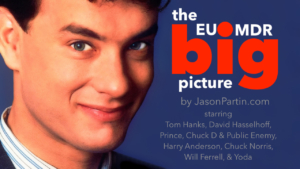
A global organization, the International Standards Organization publishes standards that are recognized as best-practices for corporate policies and procedures. ISO standards are not required but are recognized by most governments, including:
- ISO 13485, quality system control for medical device manufacturers and companies
- ISO 14971, risk management for medical devices and healthcare
ISO 13485 emphasizes the process approach and reducing risk to patients, but most people don’t understand the process approach therefore misunderstand the regulations. I use pop culture to explain what is, and what is not, the process approach to continuous improvement. I start with MC Hammer and Vanilla Ice, two hip-hop artists from the 1980’s and 90’s famous for the lines, “Stop! Hammertime!” and “Stop! Collaborate and Listen!”
We go from this:
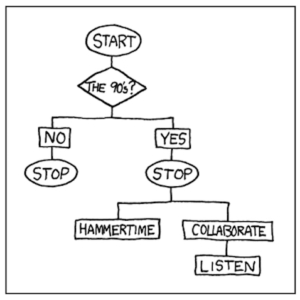
To this:
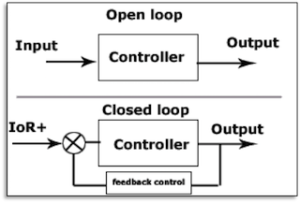
To this:
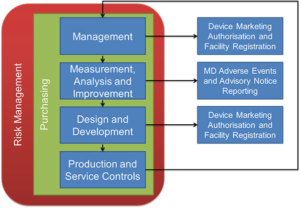
To this:

Life is short. Have fun.
The Medical Device Single Audit Program, MDSAP, is an attempt by multiple governments to simplify the process of companies preparing for government audits. The United States is one of the participating governments, and the process is a voluntary and inclusive global organization.
For MDSAP, I use two examples from 1986 to explain concepts of risk management and purchasing, the Space Shuttle Challenger explosion resulting from a flaw in a purchased component.
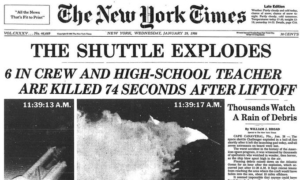
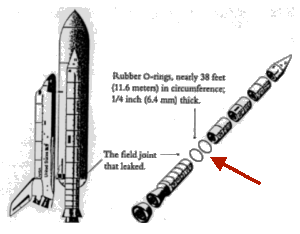
I use another phenomenon from 1986 that didn’t reach the same level of global significance, the film Crocodile Dundee, about an Australian, Crocodile Hunter (ACH, commas matter) in New York who made a risk-based decision when he chose to say, in a thick Australian accent, “That’s not a knaife. This is a knaife!”
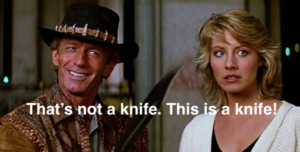
Here, watch the scene. Pause, the a moment, and enjoy the improbability of these things happening simultaneously.
One of the countries leading MDSAP is Australia, Crocodile Dundee’s home country, where he will “throw anotha shrimp on the barbie for ya.” I used Australia’s version of the MDSAP image because it represents the closed loop, process approach to risk-management.
Stories help us see bigger-picture concepts. I’ve applied statistics to student-reviews and feedback, validating what I just said; I use that process in courses on statistical analysis for process controls, design of experiments, marketing feedback, and continuous improvement.
All information is free for anyone searching the internet for ways to achieve goals, or able to search the internet for ways to achieve goals, or realize that they can find their own process. I train and consult on Kaizen, Risk Management, and Process Oriented Quality Assurance. I include ways to apply these concepts across an organization, and tips and tricks for future entrepreneurs, emphasizing patent protection, funding strategies, and identifying needs that give a bit extra for those who started with less.
The Kaizen approach is to business what religion advises: focus on the moment and take measurable steps forward towards a goal. This is usually through a company’s quality system, a way to monitor and improve progress towards a goal.
I share analogies from diverse cultures, professions, and philosophies to help as many people as possible understand fundamental concepts. In other words, I’m trying to convey the concept of a system of linked processes of continuous mutual improvement, a core requirement of the International Standards Organization, FDA, EU-MDR, NGSS, etc.
My beliefs stem from my experiences, which would most effectively be conveyed through a story.
The day after my mother died, Mike asked me, “In all of your travels, have you learned what is the meaning of all of this?” Mike had been my mother’s partner for 17 years, and had been like a stepfather to me. We were standing in my mother’s kitchen as he gestured with teary eyes, implying “all of this” included sadness of loss, joy of sharing meals, love of people, and the pain of making sense of it all. He had recently lost his mom, too. He had known me since I was a kid, leaving the foster system and rejoining my mom when she obtained custody. Mike had always been a kind, compassionate person who loved his large Catholic family. Their family tree was an extensive list of aunts, uncles, cousins, nieces, nephews, grandkids, great grandkids, and great-great grandkids, branching across southern Louisiana like stately oak trees.

Our family tree looked like a stick.

I listened to his suffering. I answered in a way that Mike would have known, and was best for us at that moment. I said, “The answer is 42.”
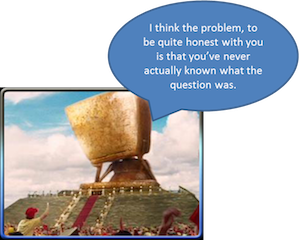
My answer made sense to Mike because he knew me, that I enjoyed reading funny science fiction novels and had a life-long interest in different religions. He knew that I was sad and suffering and trying my best to make sense of my mom’s death the day before, using humor to pause so that I could stop crying while still allowing myself to be sad.
42 is from the Hitchiker’s Guide to the Galaxy, a book following the final human from earth as he reluctantly hitchhikes with an interplanetary guidebook writer. In their world, society built a computer to calculate the answer to Life, the Universe and Everything. The computer had taken millions of years to process all variables. While waiting millions of years, people built religions around anticipation of the answer, fought wars, pontificated possibilities, speculated, considered improbabilities improperly, etc.
In the end, the computer answered, “42 is the answer.” Everyone asked what the question was, and the computer said, “Oh! You didn’t ask that. I only have the answer. You’ll have to build another computer to find out the question.”
They started building the next computer to tell them the question to Life, The Universe, and Everything, creating religions and debating philosophies, fighting wars and making peace, and almost stumbled across the question when the earth was blown up by an overly bureaucratic interplanetary highway construction crew.
One human male survived, in his bathrobe, and has been hitchhiking around the galaxy since, using was surprisingly like an app on today’s smart phone called The Hitchhiker’s Guide to the Galaxy.
The entire book was a series of improbable but coincidental events, and in the end the only point was to entertain the reader, to have fun, and to be kind.
Mike also knew that I had recently returned from a three-month trek across the Himalaya Mountains, attending the world’s first conference on Philosophy and Modern Science, hosted by the Dali Lama at the Tibetan University’s 50th Anniversary celebration. While staying at a monastery that used proceeds to run a free healthcare clinic for Tibetan Refugees and promotes environmental stewardship. They epitomize a compassionate, sustainable, equitable business, and I respect BenChen Monastery in Kathmandu. A week into staying at the monastery, I returned books to their library and saw a copy of The Hitchiker’s Guide to the Galaxy.
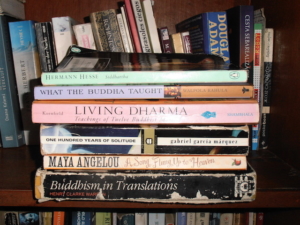
A few months later, I believe that Elon Musk launched his convertible car into space with a desk-top sticker that said “Don’t Panic,” the logo of the Hitchiker’s Guide to the Galaxy.
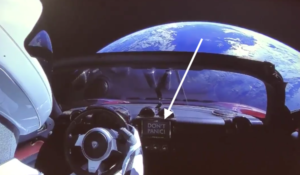
Life’s funny every time you pause to look at it closely enough, and Mike would have known that I had been a peacekeeper and communications liaison in the the Multi-National Force and Observers, collaborating with people representing 17 countries that collectively share common goals and, coincidentally, common themes in the most common religions of those countries: Christianity, Islam, Hinduism, Buddhism, and Taoism. Before that, I had been a paratrooper in the 504th Parachute Infantry Regiment of the 82nd Airborne Division, decorated for many things including humane treatment of prisoners of war we captured in combat; we gave them our blankets, shared our food, and treated them as our neighbors. We were civil.
Here’s what I think I said to Mike, though it felt more like an emotional dump:
“Maybe the point is 42, to enjoy the ride as much as possible without hurting anyone else.
2,600 years ago in Nepal, a prince with a life of luxury saw four people suffering: a sick person, an old person, a dead body, and a person sacrificing comfort hoping for spiritual understanding. The prince left his kingdom to find a solution to suffering; six years later he became the Buddha. Even most Buddhist don’t realize that the fourth person represents anyone choosing to suffer because they seek things that can’t be answered during our time on earth. According to the Buddha, we can end all suffering by following a righteous path, and that path doesn’t need more meaning than to end suffering.
Jesus said that his most important guidelines were to follow the Ten Commandments, to love God with all of our heart, and to love our neighbor as we love ourselves. He defined a neighbor as anyone who needed help, and give to the poor to be perfect.
The Buddha summarized his teachings as developing compassion and wisdom. Jesus summarized all teachings of the Bible into love, forgiveness, and charity. Mohamed said that one of the five pillars of Islam is charity, and Hinduism emphasizes doing our duty to the best of our ability.
So maybe the answer to Life, the Universe, and Everything is 42, to enjoy life without harming anyone else, and try to help anyone in need. Maybe that’s what she did when she helped animals at the shelter; maybe she was trying her best to make sense of the world through compassion and sharing her time with any person or animal in need. Her compassion to the suffering of others is why I love her, and I wish I had more time with her.”
Mike and I cried for a while. My thoughts had refined for the audience that would read her obituary.

Wendy Rothdram Partin, a resident of St. Francisville, LA, passed way on Friday, April 5th, 2019 at the age of 63. Wendy attended Glenoaks High School in Baton Rouge, LA, and retired from Exxon Mobil. She is survived by her son, Jason Ian Partin, of San Diego, CA. She was preceded in death by her mother, Joyce Rothdram, and her aunt and uncle, Lois and Robert Desico, all of Baton Rouge, LA. During her retirement, she became a master gardener and enjoyed helping people with their lawns. She enjoyed cooking, and took food to anyone she knew who was ill or grieving. Wendy loved animals, and worked with local shelters to foster dogs until they found permanent homes. She passed away unexpectedly from liver failure. In lieu of gifts or a service, please spend time sharing what you love with your neighbor, listen to what they love, and help each other.
On my bookshelf is a bookmark with her obituary. On the back of it I included a quote from the New Testament, Matthew 6:34:
“Therefore do not worry about tomorrow, for tomorrow will worry about itself. Each day has enough trouble of its own.
I felt that quote from Matthew matched statements from the Buddha,
“Don’t worry about the future or dwell on the past, focus on the present.”
I don’t adhere to a religion, but throughout my life I’ve sought to understand religions and how they influence people. I believe that the purpose of life is to enjoy it without harming anyone else, and I’ve felt compelled to help people less fortunate since I was a teenager. The reason for this is most efficiently conveyed by a story within the story of why I love my mom:
I was in the foster system until I was 5 years old, and emancipated, declared a legal adult by a court of law, at age 16. I joined the army before I was 17, becoming the youngest soldier in the first Gulf War by 18 and eventually a peacekeeper in the Middle East. I saw a lot of death and avoidable suffering before obtaining multiple engineering degrees and becoming a physics teacher. Over time, I understood more about science, statistics, and probability; I realized that what it means to not harm anyone has changed.
Poverty, inequity, population growth, and climate change result from human choices, though often those choices were with less information. We know more now. I wonder if I could not do harm simply by giving a bit more. In the words of Dr. Martin Luther King, “The only thing that evil needs to succeed is for good men to do nothing.”
Part of the reason I have had time to reflect on these things is that I am financially secure. This is more luck than skill; I was fortunate to be born a white male in America. My military service led to a lifetime of free healthcare because of service-connected injuries, and mentors helped me apply my skills entrepreneurially. The result is that I free up many hours each day from not having a boss, not commuting, and not worrying. I imagine that millions of smarter, harder working people all over the world could do more good with my good luck.
I try to share my opportunities, using religion to relate with many people who may have heard these same teachings, things that unite us. All teachings guide us to do our work privately, to be cautious of those who flaunt good deeds, of hypocrites who say words but are like the blind leading the blind. False views on these teachings have been used to justify atrocities such as war and slavery, and hate groups pick words that suit their means.
In short: do good, but do it quietly.
I loved my mother for many reasons, including that she practiced the intentions of religions more than most people who claim to be religious. She brought food to ill or grieving neighbors and cared for abandoned animals. She was not perfect, nor was our relationship perfect. But, she was compassionate to her neighbor, and though she did not have an abundance of mental energy to deal with many humans she was able to be kind to helpless animals and any human neighbor who was ill or in need.
When I spoke at her ceremony, where a few friends gathered to help Mike and me spread her ashes along with the ashes of Angel, her beloved dog, I stopped in the middle of speaking because I suddenly, inexplicably realized why Buddha, Jesus, and Mohamed all say that you should honor your mother and father. Without thinking, I shared my thoughts outlaid as I realized it’s not a rule to be followed blindly, it’s a goal, a place to be, a way to feel. I’m grateful for my mother and father. They gave me life.
I believe that the greatest gift that we can give someone is time, the ability to give to others, to experience what my mom experienced by helping her neighbors and her dog’s from her town’s any person or animal in need, to the best of her ability.
Maybe SEO has a purpose beyond adding search engine keywords to my bio. Maybe the stories within stories repeating key words conveys conviction more than if I had simply said that I was a paratrooper in the 82nd Airborne and a peacekeeper in the Multinational Force and Observers. As a civilian, I patented medical device implants and systems with teams that commercialized them. I’ve been faculty at two universities and participated in creating project-based learning programs at public high schools with outreach programs in Engineering, Physics, and Entrepreneurship, Ultimate Frisbee. I believe that we could help the world by sharing a free Frisbee with everyone, and equitable education and healthcare are stepping stones towards bigger picture goals.
Now, I’ll summarize my bio to repeat, I mean to emphasize, key words and concepts.
I lead corporate workshops and consult to improve the work-life balance of employees so that they are more empowered to do their jobs efficiently and benefit society. My workshops are effective use of laws and regulations in healthcare and education.
FDA CFR 320, medical device design controls, manufacturing process controls, and quality system continuous improvement.
ISO, ISO 13485, and ISO 14971, medical device quality control through the process-approach of reducing risk to patients, and the methods of Risk Management specific to healthcare, where consumers are not informed like they are in most product choices.
Healthcare, and our ability to innovate as a global society, depends on our education system. The new standards for science education in public schools, the Next Generation Science Standards, which introduce engineering as a core science, emphasizes team-driven innovation, and emphasizes the need for cross-disciplinary academic projects that more realistically simulate real-world work and goals.
NGSS is trying to move society away from a school system that relies on memorization, allowing kids to demonstrate knowledge by creating work that achieves goals and collaborates with other people and multiple disciplines. The NGSS clearly states that those goals should include individual awareness of the cause-and-effect of actions, including the effects of population growth, climate change or natural disasters, food supplies, etc. There is no right or wrong, there is only factual data, experiential evidence, and the ability to communicate across diverse cultures and disciplines.
Our past education system led to ineffective corporate cultures. Effective corporate cultures evolved to be more innovative, more inclusive, more lean, and more fun to work for. My consulting work includes increasing work-life balance among employees. Part of that is understanding laws and regulations so that work can be done legally and efficiently, and part is the culture that allows us to collaborate towards larger goals, just like the Next Generation Science Standards hope to fasciliate kids collaborating rather than competing.
Key concepts that must be cultivated in each organization. Global sustainability will stem from equitable education.
EQUITABLE, giving a bit more to those who start with less.
EMPATHY, to recognize the emotions of others
COMPASSION, to understand that others suffer and wish to relieve their suffering, to be with their passion, their suffering, and to wish them relief from suffering just as we wish to not suffer.
KINDNESS, to not be hurtful or harmful to others, to restrain our words and actions based on empathy and compassion.
MINDFULNESS, to be aware of ourselves, the reasons for our words and actions, and to be able to restrain from harmful words and actions by being aware of the cause and effect of our words and actions.
ABUNDANCE, to have enough to share, to have enough time, resources, or kindness so that others benefit with us.
COLLABORATION, working with diverse people and disciplines towards shared goals that are obtainable, measurable, and beneficial to the most people.
LEGAL LITERACY, understanding and applying the rules and regulations that govern our current system
FINANCIAL LITERACY, the practical realities of sustainable businesses, to allow our business to be profitable enough that work can spread and benefit others safely, cost-effectively, and equitably.
CAUSE AND EFFECT, the consequences of actions or inaction on ourselves and others.
KAIZEN, continuous improvement by planning and taking the smallest obtainable step towards a larger goal, and the process of documenting that plan and goal for clarity and transparency in an organization.
WORK-LIFE BALANCE and WORK-LIFE HARMONY, the process narrowing the gap between who you are and what you do.
Jason Ian Partin
#JipBit

